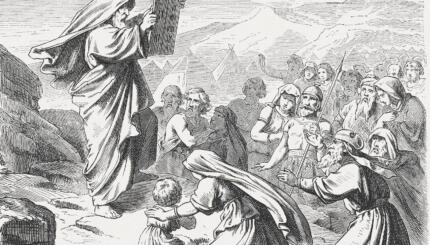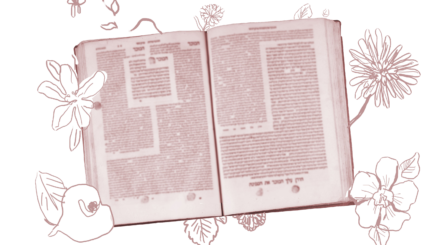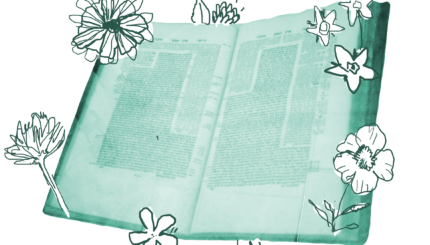Commentary on Parashat Chukat, Numbers 19:1 - 22:1
Miriam, like Moses and Aaron, was a child of Amram and Jochebed (also known as Yocheved), both of the tribe of Levi. The prophet Micah recognizes all three siblings as Israel’s leaders when he proclaims in God’s name: “I redeemed you from the house of bondage, and sent Moses, Aaron, and Miriam to lead you” (Micah 6:4). Although the Bible preserves only a few direct references to Miriam, her importance to the Israelites’ story shines through even this leanest of biographical sketches.
First, Miriam is called a prophet (in Exodus 15:20), although her prophetic teachings are not recorded. Second, she sings and leads the women in song to God following her people’s safe passage across the Sea of Reeds, or Red Sea (Exodus 15:21). Third, she (along with Aaron) speaks out against Moses about his wife and his authority (Numbers 12:1-2). Fourth, she is shut out of the camp when she is stricken with skin disease; tellingly, the Israelites refuse to move on until she returns (Numbers 12:10-15). Finally, she dies and is buried in Kadesh (Numbers 20:1), a place name that evokes the holy (kadosh is Hebrew for holy). These few references to Miriam are but clues to the larger story of her life and importance.
Let us imagine that larger story by creating a midrash. Picture Moses as he climbed Mount Nebo to see the Promised Land he would never enter and to experience God’s drawing out his soul as gently as a kiss draws out the breath (Deuteronomy 34). What was he thinking at that moment? In the midrash we are creating we may imagine that this inspiring leader thought about the future of his people and about who would preserve the Covenant for future generations. First, he considered Aaron’s son Eleazar, who would carryon the priestly functions; he could reassure himself that the priests would preserve the teachings of the Torah. Indeed, for a time, the priests did maintain their role.
However, following the destruction of the Second Temple, the priests no longer played a central role in the people’s observance of the Covenant. Moses then thought of Joshua, who was chosen to lead the Israelites into the Promised Land. He could reassure himself that through the land, the faith would be preserved. Yet for nearly two millennia, the people of Israel would live in exile from the Promised Land. Finally, Moses then thought of Miriam. But failing to recognize earlier what she had contributed to preserving the faith, he realized that he had made no effort to ensure that her function be taken up by someone else.
Leadership Lost
Was there a leadership role that was lost with the death of Miriam? If the Israelites were to remain true to their religion in the generations to come, it would be because the women passed their faith and traditions on to their children. Moses’ efforts had gone into legislating primarily for the Israelite men and had largely neglected to consider the roles of women, who were often invisible in the legal codes. In our midrash, however, Miriam had seen to the women and the education of the children.
What qualifications would there be for Miriam’s successor? Eleazar was destined for his priestly role by virtue of his lineage. Joshua had been chosen because he was judged to be a capable military commander. But whoever was to succeed Miriam would have to qualify directly through God’s gift, because no one had thought to name a successor. Moses, in that one prescient moment, understood that a vital piece of the community might have died with Miriam.
But it did not die, although it became obscured. Miriam’s legacy, which we are just beginning to retrieve, models our capacity to care for those more vulnerable than ourselves (as she did for her infant brother), to intervene in history regardless of our position (as she did when she approached the princess and when she challenged Moses’ conduct and leadership), and to dance as well as to sing publicly as a form of worship.
In this Torah portion, we learn something else as well: “The Israelites arrived in a body at the wilderness of Zin on the first new moon, and the people stayed at Kadesh. Miriam died there and was buried there. The community was without water, and they joined against Moses and Aaron” (20:1-2). Rabbinic tradition, recognizing that something of major import was lost with the death of Miriam, found in the juxtaposition of Miriam’s death with the peoples’ crying out for water a powerful symbol for this loss. A midrash tells us that throughout the Israelites’ sojourn in the wilderness, a well followed them. With the death of Miriam, the well dried up. How can we best understand what Miriam’s Well represented?
Centers of Practice
Israel in the Bible had two main centers of practice: the Tent of Meeting (or Tabernacle, later replaced by the Temple) and the home. The rules governing the Tent of Meeting take up much of Leviticus, but the life that is to be conducted in the home receives relatively little mention. Moses, we might say, had focused on institutional religion. But in our midrashic rendering of the story, Miriam’s gift was to raise up the personal practices of the Israelites and to help the women of Israel recognize and claim their homes as a sacred place. Each woman’s own Sabbath table became like an altar. While Moses showed the Israelites the God who spoke to them from the top of Sinai, Miriam enabled the women to see that God could also be found around the cooking fires in their own tents.
Miriam also helped the women change their idea of holy space (from the set-apart Tent of Meeting to their own homes). In a time when the male leaders were focusing on all that was separate and distinct, Miriam taught the women to find the holy wherever they were open to it, whenever they could be responsive.
And just as her imagined teachings sought to move beyond separation, her own tradition is not to be found in a separate text but in the words that mothers have told their daughters and sons since then: God is found in and through all that we remember, all that we experience, all that we hope for. Miriam’s Well stands for what is nourishing and life-giving-it stands for the dining table, the cradle, and the welcoming embrace of our loved ones.
Reprinted with permission from The Torah: A Women’s Commentary, edited by Tamara Cohn Eskenazi and Andrea L. Weiss (New York: URJ Press and Women of Reform Judaism, 2008).


